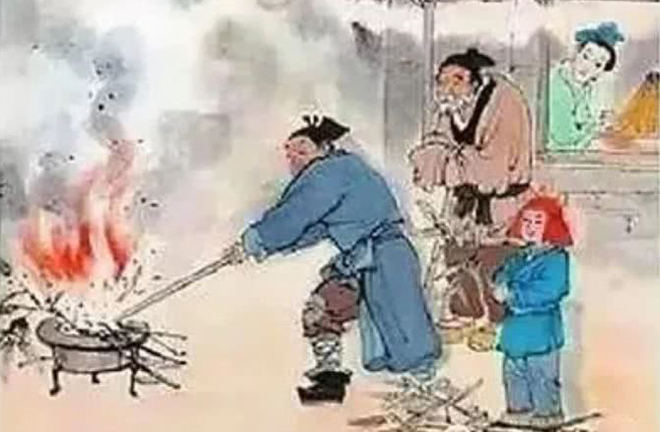Studying ancient East Asian disaster history holistically

Ancient people from the Tang Dynasty burnt medicinal materials to expel filthy air caused by the plague. Photo: FILE
As the study of ancient disaster history deepens, fruitful research results are yielded. However, current study tends to be fragmented in its research perspective, research topics tend to be monotonous, and interdisciplinary interaction is insufficient. Scholars mostly focus on the study of their own countries but neglect the similarity, correlation, and differences between countries of the same region in dealing with disasters. Some difficulties thus still haunt this field of study.
Ripple effect existed within region
Scholars seldom analyze from holistic East Asian perspectives, which makes it difficult for readers to know about the outbreak and spread of disasters among different countries on a concurrent basis. For example, it was recorded in Japanese chronicles that during 735—737, the Kingdom of Silla, an ancient state located in the Korean Peninsula was consecutively plagued by years of droughts and smallpox outbreaks. The smallpox plague later spread from the southern part of Silla to Japan, making the Japanese population plummet. Economic and social development was also severely set back as a consequence. It can be seen that once a country in East Asia was afflicted with great disaster, other countries may also be affected and a ripple effect would ensue. Therefore, if the research perspective is limited to one single country, the spatial and temporal distribution of disasters and internal relevance will be overlooked.
Geographically speaking, East Asia, which is on the edge of Eurasia, has the world’s most typical monsoonal climate and is suitable for the planting of a variety of crops. The dissemination of crops and farming skills among the ancient East Asian countries were not rare in history. For example, after rice planting skills stemmed from the lower reaches of the Yangtze River spread to Japan and the Korean Peninsula, similar farming civilizations were formed within these regions.
Due to the complexity of geological conditions, East Asia has always been a region where catastrophic floods, volcanic explosions, and great earthquakes frequently occur. Take the seventh to ninth centuries as an example. The East Asian countries were Tang Dynasty, China, the Kingdom of Silla, and Heian-era Japan during this period. The extant historical materials elaborate on disasters which afflicted all three countries, including inundation, droughts, and plagues of locusts. Overall, the types of disasters striking ancient East Asia had much in common.
East Asia as a cultural entirety
From a cultural perspective, the ancient East Asian world was an organic whole in terms of its cultural structure—a China-centered cultural sphere deeply impacted by Han culture was formed in this region. In introducing Chinese culture to their own territories, other countries were actively learning about the concepts regarding disasters and countermeasures from ancient China. Under the influence of Confucian thinking and Buddhism, the ancient Korean Peninsula and Japan also took ruling by virtue, upholding Buddhism, and offering sacrifices to gods and ancestors as necessary means of tackling disaster. All these actions manifested the ancient East Asian countries’ mutual exchange and experience drawing in coping with disasters.
In short, the ancient East Asian countries were usually under attack by similar natural disasters simultaneously, and the common cultural sphere dictated these countries’ similar conceptual understandings of natural disasters. Therefore, a possible research option is an attempt at systematic and holistic angles, extending beyond one single country to East Asia as an entirety and adopting grand perspectives to figure out the similarities and differences of disasters. In this way, the established research framework of ancient disaster history in East Asia is broadened, and China’s own study in this area can be deepened as well.
Advised ways of research transition
To transit the research paradigm and perspective in this field, it is advised as follows.
The holistic approach comes first. Through delving into disaster information and pertinent relief measures recorded in historical materials scattered around different countries, the overall trend of disasters can be grasped. For example, perusing books such as The Old History of Tang Dynasty, History of the Three Kingdoms, Nihon Shoki and other historical books will give scholars an understanding of whether the disasters struck a particular country or the whole of East Asia, based on summarizing the concepts and means of governance on disasters and achievements in battling against them.
The next step is to summarize the past experiences which can provide reference to today’s reality and make the history and present interact with each other. Take Donguibokam (Precious Mirror of Oriental Medicine) as an example. This book was compiled by a Korean medical scholar based on studying and editing many ancient Chinese medical books. According to the True Record of the Chosun Dynasty, prescriptions of traditional Chinese medicine recorded in Donguibokam once played a vital role in pandemic therapies.
After the COVID-19 pandemic broke out, Japanese and South Korean medical fields tried to use traditional Chinese medicine prescriptions for treating patients, and considerable effects have been yielded. Therefore, the disaster prevention and alleviation research in ancient and today’s East Asia combined will not only help forge distinctive theories that are unique to East Asia, but also offer experience for countries within this region to cooperate with each other and weather the crisis.
Lin Zejie and Bai Genxing are from the School of History and Civilization at Shaanxi Normal University.
Edited by BAI LE

 PRINT
PRINT CLOSE
CLOSE